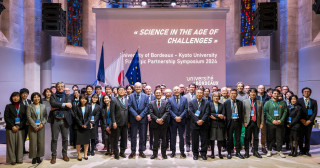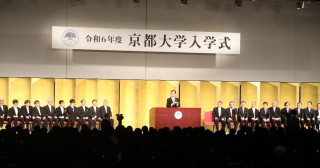From 1 December through late March, the exhibit "Latest achievements in earth and space science simulated by classroom-friendly 3D digital globe 'Dagik Earth'" will take place in the publicly-accessible "Joho-hiroba (information space)" of the science ministry MEXT in Tokyo.
The Dagik Earth system was developed by Associate Professor Akinori Saito and colleagues of the KU Graduate School of Science, in collaboration with the National Institute of Information and Communication Technology, the Japan Aerospace Exploration Agency, and Shizuoka University, supported by a MEXT grant for the promotion of space science and technology (FY2013 to 2015).
While astronomical objects, such as the Earth, the moon, and the planets, inevitably get distorted when they are projected on flat screens, the Dagik Earth system projects three-dimensional images in their actuality on a spherical screen, making understanding of astronomical phenomena intuitive. The system can be installed in an ordinary classroom, using a personal computer and a projector, in a relatively small space.
The exhibit includes the latest images obtained by the Venus Climate Orbiter "Akatsuki", lunar orbiter "Kaguya", the Japanese Geostationary Meteorological Satellite "Himawari", and the Advanced Land Observing Satellite "Daichi".

"Dagik Earth" digital globe system
Exhibition details
Date: Thu 1 Dec 2016 -- Tue 21 Mar 2017 (end date may change)
Place: MEXT "Joho-hiroba" exhibition room (former MEXT building 3rd floor)
Time: 10:00-18:00 (last entry 17:30)
Fee: free
Closed: Saturdays, Sundays, national holidays, and over the New Year
Exhibits include:
- Wall-hung 3-D digital globe (90-cm spherical screen)
- Desktop 3-D digital globe (20-cm spherical screen)
- Panels explaining Dagik Earth's development
Related links
- Dagik Earth enables digital globe projection using iPads (28 April 2016)
http://www.kyoto-u.ac.jp/en/about/events_news/department/rigaku_u/news/2016/160425_1.html - Dagik Earth
https://www.dagik.net/english/





